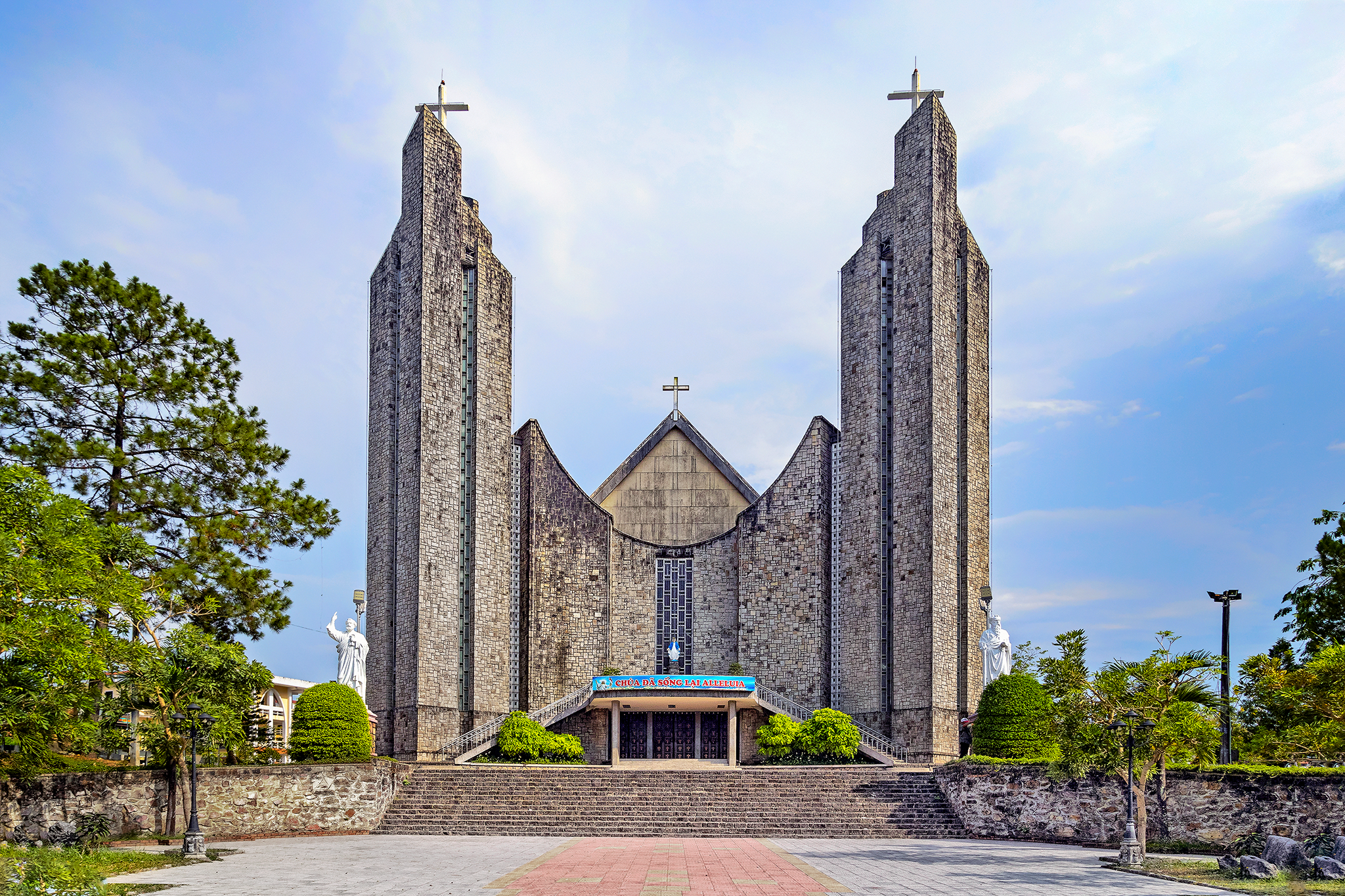
Introduction to Phu Cam Cathedral
Perched on a tranquil hill in the heart of Hue, Phu Cam Cathedral, officially known as the Cathedral of the Immaculate Heart of Mary, is a striking landmark that captivates both the faithful and architecture lovers alike. Designed by the renowned Vietnamese architect Ngô Viết Thụ, the cathedral stands out with a unique silhouette reminiscent of an open Bible—a powerful symbol of spreading the Gospel. Beyond its religious significance, Phu Cam Cathedral is an architectural marvel and a historical treasure that draws visitors eager to explore its artistic brilliance and rich heritage.
A Journey Through Time: The History of Phu Cam Cathedral
Phu Cam Cathedral’s history weaves through centuries of change, echoing the resilience and cultural spirit of Hue. The site’s origins trace back to the late 17th century, when modest chapels served the local Catholic community. However, the magnificent structure we see today is the result of multiple reconstructions and architectural transformations over the centuries.
The current cathedral’s construction began in 1963 under Ngô Viết Thụ’s vision but faced prolonged interruptions due to the Vietnam War and socio-political challenges. It wasn’t until 2000 that the cathedral was finally completed, standing today as a symbol of faith and endurance. This long journey imbues the cathedral with profound historical and cultural significance, making it a living museum that reflects Hue’s turbulent yet enduring past.
Architectural Features: A Symphony of Modernity and Tradition
Phu Cam Cathedral is a masterpiece of modern architectural design. Ngô Viết Thụ’s innovative approach breaks away from traditional church architecture, creating a structure that is both minimalist and deeply symbolic.
- Facade: The cathedral’s facade resembles an open Bible, symbolizing openness and the spread of faith. Its sharp, clean lines give it a contemporary aesthetic rarely seen in ecclesiastical buildings.
- Interior: Inside, visitors are greeted by towering concrete arches and vibrant stained-glass windows that cast beautiful kaleidoscopic patterns across the floor. The grand altar serves as the centerpiece, exuding elegance and serenity.
- Vietnamese Influence: Subtle touches throughout the building pay homage to Vietnamese culture, blending Eastern motifs with Western design principles for a harmonious and unique atmosphere.
Every corner of Phu Cam Cathedral offers an exquisite interplay of light, space, and form, making it a destination not only for worshippers but also for architecture enthusiasts and photographers.
Nearby Attractions to Complement Your Visit
A trip to Phu Cam Cathedral offers the perfect opportunity to explore more of Hue’s rich cultural and historical landscape. Here are some nearby attractions you shouldn’t miss:
The Imperial City of Hue
Just a short distance from the cathedral, the Imperial City of Hue stands as a grand testament to the Nguyen Dynasty, Vietnam’s last royal family. This UNESCO World Heritage Site encompasses:
- Palaces, temples, and pavilions
- The Forbidden Purple City, once the emperor’s private quarters
- Architectural gems like the Thai Hoa Palace and Hall of the Mandarins
Strolling through this vast complex is like stepping back into the royal past, surrounded by the artistry and grandeur of imperial Vietnam.
Thien Mu Pagoda
Located along the Perfume River, the Thien Mu Pagoda is one of Hue’s most iconic landmarks. Built in 1601, the pagoda is famous for:
- The seven-story octagonal Phuoc Duyen Tower
- Serene gardens and intricate Buddhist statues
- Historical significance, including its association with the monk Thich Quang Duc
From its grounds, visitors enjoy stunning views over the river and the surrounding landscape—a place of peace and contemplation.
Tombs of the Nguyen Emperors
Hue is renowned for its elaborate imperial tombs, each offering a glimpse into the lives and personalities of the Nguyen emperors:
- Tu Duc Tomb: Known for its poetic scenery and tranquil lakes.
- Khai Dinh Tomb: A fusion of Eastern and Western styles, adorned with ornate mosaics.
- Minh Mang Tomb: Majestic and symmetrical, reflecting Confucian ideals.
These sites reveal the emperors’ devotion to art, spirituality, and the afterlife, making them must-see destinations for any history lover.
Dong Ba Market
For a taste of local life, Dong Ba Market is an essential stop. As Hue’s largest market, it bursts with energy and color, offering:
- Fresh produce, seafood, and local delicacies like bún bò Huế (Hue beef noodle soup)
- Traditional crafts, textiles, and souvenirs
- A vibrant, authentic atmosphere
Exploring the market is a sensory delight and a fantastic way to connect with Hue’s everyday culture.
Perfume River (Huong River)
The Perfume River meanders through the heart of Hue, lending poetic charm to the city. A scenic boat ride along its gentle waters provides views of:
- The Imperial City
- Thien Mu Pagoda
- Verdant countryside and distant mountains
The river is especially breathtaking at sunset, when the sky blazes with brilliant hues, creating an unforgettable, romantic experience.
Photography Tips for Phu Cam Cathedral
Phu Cam Cathedral offers numerous photographic opportunities, thanks to its dramatic architecture and atmospheric setting. Here are some expert tips:
- Best Angles:
- Capture the entire facade from the front to emphasize its open-Bible design.
- Shoot from the side to highlight the cathedral’s sleek, modern lines.
- Step inside for shots of the soaring arches and colorful stained glass.
- Lighting:
- Early morning (6:00–8:00 AM) or late afternoon (4:00–6:00 PM) provides soft, golden light perfect for warm, vibrant images.
- Avoid midday light to prevent harsh shadows and washed-out colors.
- Composition:
- Include foreground elements like trees or visitors for depth.
- Experiment with symmetry to emphasize the cathedral’s geometric design.



